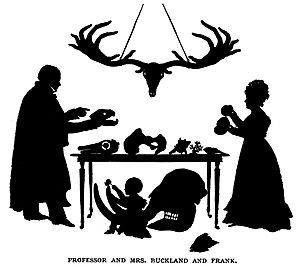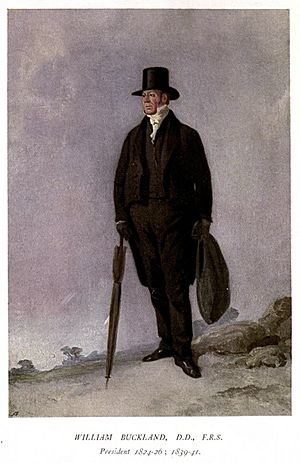William Buckland facts for kids
Quick facts for kids The Reverend William Buckland FRS |
|
|---|---|
| Dean of Westminster | |

Buckland in 1833
|
|
| Personal details | |
| Born | 12 March 1784 Axminster, Devon, England |
| Died | 14 August 1856 (aged 72) Islip, Oxfordshire, England |
| Denomination | Anglican |
| Spouse | |
| Alma mater | Winchester College, Corpus Christi College, Oxford |
William Buckland DD, FRS (12 March 1784 – 14 August 1856) was an English theologian who became Dean of Westminster. He was also a geologist and palaeontologist.
Buckland wrote the first full account of a fossil dinosaur, which he named Megalosaurus. His work proved that Kirkdale Cave in North Yorkshire had been a prehistoric hyena den, for which he was awarded the Copley Medal. It was praised as an example of how scientific analysis could reconstruct distant events. He pioneered the use of fossilised faeces in reconstructing ecosystems, coining the term coprolites.
Buckland followed the Gap Theory in interpreting the biblical account of Genesis as two widely separated episodes of creation. It had emerged as a way to reconcile the scriptural account with discoveries in geology suggesting the earth was very old. Early in his career Buckland believed he had found evidence of the biblical flood, but later saw that the glaciation theory of Louis Agassiz gave a better explanation, and played a significant role in promoting it.
Contents
Early life
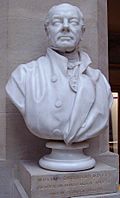
Buckland was born at Axminster in Devon and, as a child, would accompany his father, the Rector of Templeton and Trusham, on his walks where interest in road improvements led to collecting fossil shells, including ammonites, from the Jurassic-era lias rocks exposed in local quarries.
He was educated first at Blundell's School, Tiverton, Devon, and then at Winchester College, from where he won a scholarship to Corpus Christi College, Oxford, matriculating in 1801 and graduating BA in 1805. He also attended lectures of John Kidd on mineralogy and chemistry, developed an interest in geology, and carried out field research on strata during his vacations. He went on to obtain his MA degree in 1808, became a Fellow of Corpus Christi in 1809, and was ordained as a priest. He continued to make frequent geological excursions, on horseback, to various parts of England, Scotland, Ireland and Wales.
In 1813, Buckland was appointed Reader in mineralogy, in succession to John Kidd, giving lively and popular lectures with increasing emphasis on geology and palaeontology. As an unofficial curator of the Ashmolean Museum, he built up collections, touring Europe and coming into contact with scholars including Georges Cuvier.
Career, work and discoveries
Rejection of flood geology and Kirkdale Cave
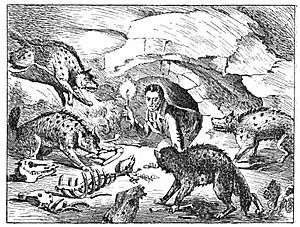
In 1818, Buckland was elected a fellow of the Royal Society. That year he persuaded the Prince Regent to endow an additional Readership, this time in Geology and he became the first holder of the new appointment, delivering his inaugural address on 15 May 1819. This was published in 1820 as Vindiciæ Geologiæ; or the Connexion of Geology with Religion explained, both justifying the new science of geology and reconciling geological evidence with the biblical accounts of creation and Noah's Flood.
At a time when others were coming under the opposing influence of James Hutton's theory of uniformitarianism, Buckland developed a new hypothesis that the word "beginning" in Genesis meant an undefined period between the origin of the earth and the creation of its current inhabitants, during which a long series of extinctions and successive creations of new kinds of plants and animals had occurred. Thus, his catastrophism theory incorporated a version of Old Earth creationism or Gap creationism. Buckland believed in a global deluge during the time of Noah but was not a supporter of flood geology as he believed that only a small amount of the strata could have been formed in the single year occupied by the deluge.
From his investigations of fossil bones at Kirkdale Cave, in Yorkshire, he concluded that the cave had actually been inhabited by hyaenas in antediluvian times, and that the fossils were the remains of these hyaenas and the animals they had eaten, rather than being remains of animals that had perished in the Flood and then carried from the tropics by the surging waters, as he and others had at first thought.
While criticised by some, Buckland's analysis of Kirkland Cave and other bone caves was widely seen as a model for how careful analysis could be used to reconstruct the Earth's past, and the Royal Society awarded Buckland the Copley Medal in 1822 for his paper on Kirkdale Cave.
While Buckland's analysis convinced him that the bones found in Kirkdale Cave had not been washed into the cave by a global flood, he still believed the thin layer of mud that covered the remains of the hyaena den had been deposited in the subsequent 'Universal Deluge'. He developed these ideas into his great scientific work Reliquiæ Diluvianæ, or, Observations on the Organic Remains attesting the Action of a Universal Deluge which was published in 1823 and became a best seller. However, over the next decade as geology continued to progress Buckland changed his mind. In his famous Bridgewater Treatise, published in 1836, he acknowledged that the biblical account of Noah's flood could not be confirmed using geological evidence. By 1840 he was very actively promoting the view that what had been interpreted as evidence of the 'Universal Deluge' two decades earlier, and subsequently of deep submergence by a new generation of geologists such as Charles Lyell, was in fact evidence of a major glaciation.
Megalosaurus
He continued to live in Corpus Christi College and, in 1824, he became president of the Geological Society of London. Here he announced the discovery, at Stonesfield, of fossil bones of a giant reptile which he named Megalosaurus ('great lizard') and wrote the first full account of what would later be called a dinosaur.
In 1825, Buckland was elected a Foreign Honorary Member of the American Academy of Arts and Sciences. That year he resigned his college fellowship: he planned to take up the living of Stoke Charity in Hampshire but, before he could take up the appointment, he was made a Canon of Christ Church, a rich reward for academic distinction without serious administrative responsibilities.
Marriage
In December 1825 he married Mary Morland of Abingdon, Oxfordshire, an accomplished illustrator and collector of fossils. Their honeymoon was a year touring Europe, with visits to famous geologists and geological sites. She continued to assist him in his work, as well as having nine children, five of whom survived to adulthood. His son Frank Buckland became a well known practical naturalist, author, and Inspector of Salmon Fisheries.
On one occasion, Mary helped him decipher footmarks found in a slab of sandstone by covering the kitchen table with paste, while he fetched their pet tortoise and confirmed his intuition, that tortoise footprints matched the fossil marks. His daughter, author Elizabeth Oke Buckland Gordon, wrote a biography of her father that included appendices of positions held by Buckland, his membership in professional societies, and an index of his publications.
The Red Lady of Paviland
On 18 January 1823 Buckland walked into Paviland Cave in south Wales, where he discovered a skeleton which he named the Red Lady of Paviland. Although Buckland found the skeleton in Paviland Cave in the same strata as the bones of extinct mammals (including mammoth), Buckland shared the view of Georges Cuvier that no humans had coexisted with any extinct animals, and he attributed the skeleton's presence there to a grave having been dug in historical times, possibly by the same people who had constructed some nearby pre-Roman fortifications, into the older layers.
Carbon-data tests have since dated the skeleton, now known to be male as from circa 33,000 years before present (BP). It is the oldest anatomically modern human found in the United Kingdom.
Coprolites and the Liassic food chain
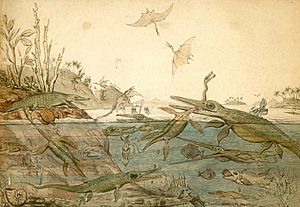
The fossil hunter Mary Anning noticed that stony objects known as "bezoar stones" were often found in the abdominal region of ichthyosaur skeletons found in the Lias formation at Lyme Regis. She also noted that if such stones were broken open they often contained fossilised fish bones and scales, and sometimes bones from small ichthyosaurs. These observations by Anning led Buckland to propose in 1829 that the stones were fossilised faeces. He coined the name coprolite for them; the name came to be the general name for all fossilised faeces.
Buckland also concluded that the spiral markings on the fossils indicated that ichthyosaurs had spiral ridges in their intestines similar to those of modern sharks, and that some of these coprolites were black because the ichthyosaur had ingested ink sacs from belemnites. He wrote a vivid description of the Liassic food chain based on these observations, which would inspire Henry De la Beche to paint Duria Antiquior, the first pictorial representation of a scene from the distant past. After De le Beche had a lithographic print made based on his original watercolour, Buckland kept a supply of the prints on hand to circulate at his lectures. He also discussed other similar objects found in other formations, including the fossilised hyena dung he had found in Kirkdale Cave.
Buckland had been helping and encouraging Roderick Murchison for some years, and in 1831 was able to suggest a good starting point in South Wales for Murchison's researches into the rocks beneath the secondary strata associated with the age of reptiles. Murchison would later name these older strata, characterised by marine invertebrate fossils, as Silurian, after a tribe that had lived in that area centuries earlier. In 1832 Buckland presided over the second meeting of the British Association, which was then held at Oxford.
Bridgewater Treatise
Buckland was commissioned to contribute one of the set of eight Bridgewater Treatises, "On the Power, Wisdom and Goodness of God, as manifested in the Creation". This took him almost five years' work and was published in 1836 with the title Geology and Mineralogy considered with reference to Natural Theology. His volume included a detailed compendium of his theories of day-age, gap theory and a form of progressive creationism where faunal succession revealed by the fossil record was explained by a series of successive divine creations that prepared the earth for humans.
Following Charles Darwin's return from the Beagle voyage, Buckland discussed with him the Galapagos land iguanas and Marine iguanas. He subsequently recommended Darwin's paper on the role of earthworms in soil formation for publication, praising it as "a new & important theory to explain Phenomena of universal occurrence on the surface of the Earth—in fact a new Geological Power", while rightly rejecting Darwin's suggestion that chalkland could have been formed in a similar way.
Glaciation theory
By this time Buckland was a prominent and influential scientific celebrity and a friend of the Tory prime minister, Sir Robert Peel. In co-operation with Adam Sedgwick and Charles Lyell, he prepared the report leading to the establishment of the Geological Survey of Great Britain.
Having become interested in the theory of Louis Agassiz, that polished and striated rocks as well as transported material, had been caused by ancient glaciers, he travelled to Switzerland, in 1838, to meet Agassiz and see for himself. He was convinced and was reminded of what he had seen in Scotland, Wales and northern England but had previously attributed to the Flood. When Agassiz came to Britain for the Glasgow meeting of the British Association, in 1840, they went on an extended tour of Scotland and found evidence there of former glaciation. In that year Buckland had become president of the Geological Society again and, despite their hostile reaction to his presentation of the theory, he was now satisfied that glaciation had been the origin of much of the surface deposits covering Britain.
In 1845 he was appointed by Sir Robert Peel to the vacant Deanery of Westminster (he succeeded Samuel Wilberforce). Soon after, he was inducted to the living of Islip, near Oxford, a preferment attached to the deanery. As Dean and head of Chapter, Buckland was involved in repair and maintenance of Westminster Abbey and in preaching suitable sermons to the rural population of Islip, while continuing to lecture on geology at Oxford. In 1847, he was appointed a trustee in the British Museum and, in 1848, he was awarded the Wollaston Medal by the Geological Society of London.
Illness and death
Around the end of 1850, William Buckland contracted a disorder of the neck and brain, and died of it in 1856. Frank Buckland reported that an autopsy showed "the portion of the base of the skull upon which the brain rested, together with the two upper vertebrae of the neck, to be in an advanced state of caries, or decay. The irritation...was quite sufficient cause to give rise to all symptoms." Frank Buckland attributed the cause of death of both his parents to a severe accident years earlier.
The plot for William's grave had been reserved, but when the gravedigger set to work, it was found that an outcrop of solid Jurassic limestone lay just below ground level and explosives had to be used for excavation. This may have been a last jest by the noted geologist, reminiscent of Richard Whately's Elegy intended for Professor Buckland written in 1820:
Where shall we our great Professor inter
That in peace may rest his bones?
If we hew him a rocky sepulchre
He'll rise and break the stones
And examine each stratum that lies around
For he's quite in his element underground
Known eccentricities
Buckland preferred to do his field palaeontology and geological work wearing an academic gown. His lectures were notable for their dramatic delivery. When he lectured indoors he would bring his presentations to life by imitating the movements of the dinosaurs under discussion. Buckland's passion for scientific observation and experiment extended to his home, where he had a table inlaid with dinosaur coprolites. The original table top is exhibited at the Lyme Regis Museum.
Not only was William Buckland's home filled with specimens – animal as well as mineral, live as well as dead – but he claimed to have eaten his way through the animal kingdom: zoophagy. The most distasteful items were mole and bluebottle fly; panther, crocodile and mouse were among the other dishes noted by guests. Buckland was followed in this hobby by his son Frank. On one occasion, Buckland (the father) consumed a portion of the mummified heart of King Louis XIV.
Legacy
Dorsum Buckland, a wrinkle ridge on the Moon, is named after him. Buckland Island (known today as Ani-Jima), in the Bonin Islands (Ogasawara-Jima), was named after him by Captain Beechey on 9 June 1827. In 1846, William Buckland was rector of St. Nicholas in Islip and is commemorated on a plaque in the south aisle of the church and the "East Window" was dedicated to the memory of Buckland and his wife in 1861. A plaque is dedicated to him near his summer home by the Old Rectory, The Walk, Islip (10 August 2008). There is also a bust by Henry Weekes in the south aisle at Westminster Abbey.
In 1972, botanist Heikki Roivainen circumscribed Bucklandiella, a genus of moss in the family Grimmiaceae, which was named in his honour. Buckland Peaks in New Zealand's Paparoa Range was named after him.
See also
 In Spanish: William Buckland para niños
In Spanish: William Buckland para niños


